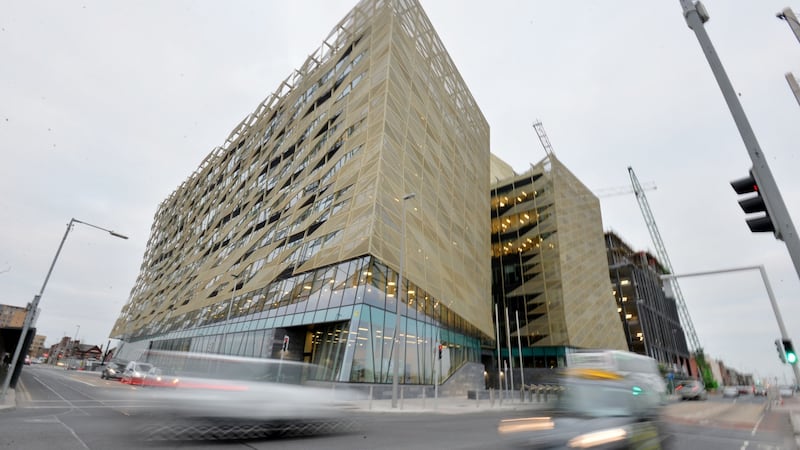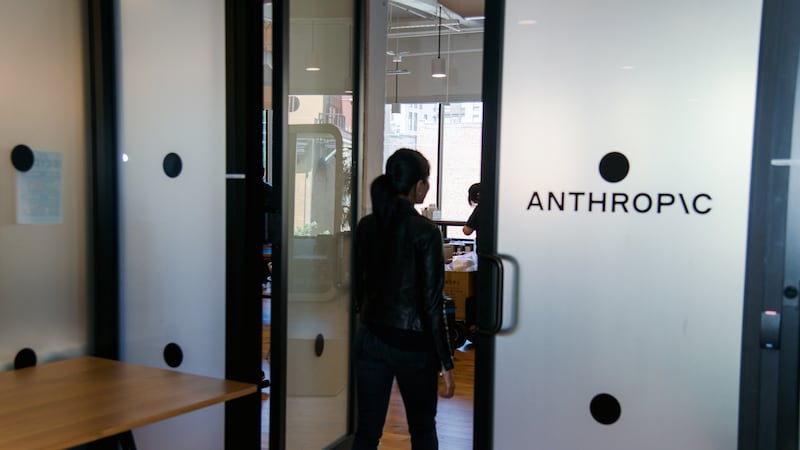The Dublin office market had another strong year in 2017 with take-up and rents approaching 2007 peaks and a strong supply line of new space under construction or about to go on site.
However, the market also showed growing signs of maturity as runaway rent increases are on the slide and some predict a slowdown in construction starts from mid-2018.
"Take-up in the Dublin office market looks set to reach 270,000sq m, surpassing last year's total, while also edging closer to the market peak of 288,000sq m in 2007," says Ronan Corbett, director and head of offices at Cushman & Wakefield. "The market is on course for another outstanding year."
He suggests prime rents in the central business district will reach €619 per sq m by year end and stabilise at €646 per sq m in 2018.
However, Marie Hunt, head of research at CBRE, suggests headline rents in Dublin 2 are about €673 per sq m (€62.50 per sq ft) and have "remained stable at this level for several quarters now. As new supply comes on stream, prime rents might moderate and eventually settle at just below €645 per square metre. The trend is towards stabilisation at the prime end of the market."
Enda Moore, a director at Hooke & MacDonald, also sees prime Dublin office rents as "stable in the medium term" while Deirdre Costello, regional director at JLL, predicts only "limited further rental growth in the city centre as, on the whole, the major growth has happened". James Meagher of Knight Frank, meanwhile, points to prelettings at present rental values moderating future rental growth as a lot of developers do deals now rather than wait for their buildings to be completed.
Not everyone, however, is convinced that prime rents have peaked. Andrew Cunningham, director of offices at Savills, says rents will peak in 2018/2019 as a squeeze on development funding is moderating the delivery of new space.
Peak
Tony Waters of HWBC also points to a slowdown in new office starts, so 2018 could see the peak of development in this cycle with less space coming on stream in 2019. "We estimate new completions for 2017 will come in at 2.4 million square feet with around 2.75 million square feet to reach completion in 2018," he says. "Strong levels of occupier demand will continue in 2018 and will be increasingly driven by domestic and government requirements. So expect tenant incentives, such as rent-free and break options, to come under pressure."
While the top end of the market may be at its rental peak, most estate agents believe that secondary and suburban office markets – particularly in the Sandyford area – may still see more rent increases in this cycle. The biggest deal this year was for the new Central Bank building of 18,400sq m at North Wall Quay in Dublin 1. This was followed by Facebook's signing for 17,500sq m at The Beckett on East Wall Road in Dublin 3, JP Morgan's purchase of 200 Capital Dock in Dublin 2 (measuring 12,100sq m) and AIB signing for 12,000sq m at Block H at Central Park in Leopardstown.

Other significant lettings included Google’s decision to acquire more than 9,290sq m at The Chase and Blackthorn House in Sandyford and Fleetmatics taking 8,361sq m at The Atrium in Sandyford Business Park.
The technology sector accounts for almost a third of demand for office space, followed by the State (18 per cent) and professional services companies (17 per cent). Ronan Corbett puts the overall vacancy rate at 8.3 per cent but this is much lower in parts of the city centre.
Looking ahead, there are a number of trends emerging in the office market that are worth watching. Principal among these is the emergence of the co-working and flexible office space model where companies and individuals rent on a short-term basis.
James Meagher estimates that co-working office space accounted for about 6.5 per cent of take-up in 2017 and, while a small share, “it was four times the level in 2016”. With such growth set to continue, he says, the co-working market could account for 10-15 per cent of take-up next year: “This means it will represent a significant disruption to the traditional landlord-tenant model. The co-working market will become very competitive and the quality of covenant will be extremely important to landlords.”
Paul Finucane of Colliers also believes 2018 will see a "rapid rise" of flexible workspace operators. "Dublin has lagged other global cities when it comes to flexible workspace," he says.
“Until recently, this market comprised local providers operating out of smaller period buildings in the city centre. The real game-changer is the recent announcement that WeWork has taken around 110,000sq ft of space in two Dublin city centre locations. We expect them to be open for business in the second/third quarter of 2018 and they will offer much needed flexible space for larger occupiers hoping to avoid long-term leases and expensive fit-outs.
“We are also aware of two other coworking operators in the market – each looking for around 40,000sq ft – so the flexible space model is here to stay.”
Another trend is growth in the number of very large lettings. Hannah Dwyer of JLL points to nine deals in 2017 for space in excess of 50,000sq ft. "Anything bigger than 50,000sq ft is considered large for Dublin," says Dwyer, "with some limited deals greater than 100,000sq ft. But five deals this year were in this larger size category – the same as the combined total for the last three years. We're expecting more of these deals at the larger-end of the scale in 2018."
Tanya Duffy, a researcher at Lisney, agrees that size will be the "stand out" feature of 2018 as "big occupiers will continue to get bigger". She believes well-known international names will "significantly increase" their presence in Dublin so the market will be "dominated by the larger occupiers making big commitments".
Brexit
Brexit could also make its presence increasingly felt. "We anticipate further activity as a result of Brexit from international companies looking to establish or grow their operations in Dublin or elsewhere in Ireland, " says Enda Moore. "The preference will be for new, high-quality modern accommodation with excellent staff amenities."
Tony Waters says Brexit will “have a bigger impact” on office take-up in 2018 as more banking, insurance and financial services companies “firm up” their post-Brexit plans. “Dublin is expected to win around 15 per cent of any post-Brexit exodus from London and already companies such as XL Insurance, Beazley and KBRA Ratings have announced Dublin as their location of choice but our housing crisis will impact on some corporate decisions.”
Financial firms establishing or expanding their operations in Dublin on account of Brexit already include JP Morgan, Barclays, Bank Of America, Merrill Lynch and Citigroup.
“Our research shows that just less than 20 per cent of all leasing activity in Dublin in the first half of 2017 was from UK companies, which is twice the normal level of UK activity,” says Hunt.
Meanwhile, Corbett believes the development focus will now shift to the north docks as there’s very few sites or refurbishment opportunities left on the southside.
“The north docks will be the place to be,” he says, “as it has fast-track planning with the special development zone status and can accommodate big floor plates.”













